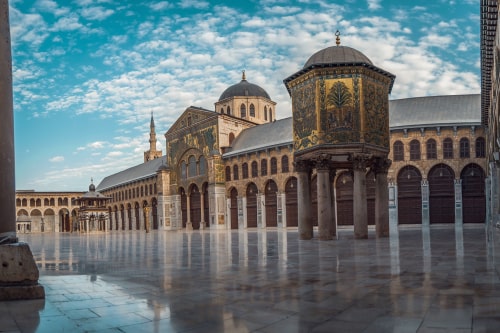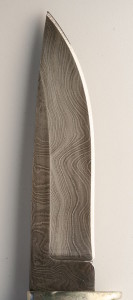Last updated on June 9th, 2021
Facts about the history and culture of Syria
20. Syria was invaded by Pompey the Great, a Roman general under Julius Ceaser, who thought himself to be the king.
21. Syria has been drinking beer to chill out since times immemorial. A historical reference to beer is found in the Ebla tablets, which date back to 2500 BC.
22. In Syria, it’s the government’s job to get you drunk! There are two varieties of beer, Al-Shark Beer and Barada Beer, both produced by the state.

Photo: Lerner Vadim / Shutterstock.com
23. The Aleppo Codex, an ancient Jewish manuscript, remained in Syria for five hundred years. It was lost during a riot in 1947, but was later smuggled into Israel by a Syrian national. The sad news: only half the pages remained.
24. The city of Aleppo in Syria was named the Islamic Capital of Culture in 2006.
25. The Al-Madina Souq, a link in the ancient silk route, is the perfect example of a tinsel town. Oblivious to the modern era, it maintains the rare charm of a medieval marketplace, filled with exotic goods and stunning architecture.
26. Qudud Halabiya and Muwashshah are the two forms of Arab music and poetry uniquely developed in Syria.
27. The internet hacktivist group Anonymous has declared war on The Syrian Electronic Army because of its censorship laws.
28. Syria has close ties with the country of Iran. The latter is believed to have spent $15 billion annually in Syria during the Syrian Civil War.
29. Palmyra, a city dripping with history and culture, was deliberately destroyed by the Islamic State of Levant due to its polytheistic statues. It is a UNESCO World Heritage Site and a rare gem of the ancient world.

Photo: mohammad alzain / Shutterstock.com
30. The fourth holiest place in Islam is the Umayyad Mosque, located in Damascus. It also is home to the mausoleum containing the tomb of King Saladin, as well as the Shrine of John the Baptist.
31. Contrary to the barbaric present, the very idea of civilization started in ancient Syria as the Mesopotamian civilization. For this reason, it is also known as the cradle of civilization.
32. The Aleppo Citadel in Syria is the mother of all citadels. Built in the year 3, BCE, it is one of the oldest and largest castles in the world, standing strong even today.
33. The Middle East’s version of absinthe, the arak, is an important part of the Levant culture, originating in the city of Aleppo.
34. The city of Bosra was the Capital of Roman Arabia. The Theater of Bosra was built just a century after the birth of Christ, and it is still used for the Bosra music festival.
35. Syria was once a tourist hotspot for its religious and historical wonders, but the war caused a 75% decline in the tourism industry.
36. Russian company Megapolis Ltd. has organized war tourism trips to the frontlines of the Syrian conflict. The other popular choice is Ukraine.

37. The capital of Syria is known for its steel. The Damascus Steel swords were feared and revered by the crusaders for their extremely sharp edges.
38. Legends have it that the first murder took place in Syria. Cain, the son of Adam and Eve, killed his brother, Abel, on Mount Qasioun, near Damascus.

39. The Norias, or the waterwheels of Hama, were built in 1361 CE and are still used.
40. The ancient Euphrates River passes through Syria. It is considered the birthplace of the first civilization in the world, the Mesopotamian Civilization.
41. Ironically, even with such a strong fort, the city of Aleppo was invaded by Romans, Byzantines, Seljuqs, Mitannians, Egyptians, Babylonians, Assyrians, Persians, Mamluks and Ottomans.
42. The city of Damascus is forever attached to Christian beliefs because the New Testament preaches that the conversion of Paul the Apostle happened on his way to Damascus.
Map of Syria
43. The great Ottoman Empire, a legacy of 624 years, was broken up by a single agreement, the Sykes-Picot Agreement of 1916. It broke the great empire off into several colonies and was a watershed moment in the evolution of the Middle East.
44. The Kurdish People form a distinctive community, which is believed to have originated from the ancient Assyrian city of Nineveh.
You can use this link to make a donation to Syria.
Syria – country at a glance
| Independence | 17 April 1946 (from League of Nations mandate under French administration) |
|---|---|
| Capital City | Damascus (33°30′N 36°18′E) |
| Largest City | Aleppo |
| Area | total: 187,437 sq km land: 185,887 sq km water: 1,550 sq km note: includes 1,295 sq km of Israeli-occupied territory |
| Population | 23,865,423 (2024 est.) |
| Official Language | Arabic |
| Demonym | Syrian |
| Literacy rate | total population: 86.4% (2015 est.) |
| Government type | presidential republic; highly authoritarian regime |
| Suffrage | 18 years of age; universal |
| President | Bashar al-Assad |
| Prime Minister | Mohammad Ghazi al-Jalali |
| National anthem | "Humat ad-Diyar" (Guardians of the Homeland) |
| National symbols | hawk |
| National colors | red, white, black, green |
| Borders | Iraq, Jordan, Israel, Lebanon and Turkey. |
| Currency | Syrian pound (SYP) |
| Religion | Islam (Sunni muslims), Syrian Arabs, with the remainder being Kurds, Turkomans, Circassians, and Palestinians. |
| Terrain | primarily semiarid and desert plateau; narrow coastal plain; mountains in west |
| Mean elevation | 514 m |
| Lowest point | unnamed location near Lake Tiberias -208 m |
| Highest point | Mount Hermon (Jabal a-Shayk) 2,814 m |
| Climate | mostly desert; hot, dry, sunny summers (June to August) and mild, rainy winters (December to February) along coast; cold weather with snow or sleet periodically in Damascus |
| Natural resources | petroleum, phosphates, chrome and manganese ores, asphalt, iron ore, rock salt, marble, gypsum, hydropower |
| Agricultural land | 75.8% |
| Birth rate | 21.7 births/1,000 population (2024 est.) |
| Death rate | 21.7 births/1,000 population (2024 est.) |
| Sex ratio | 1.01 male(s)/female (2024 est.) |
| Life expectancy at birth | 74.8 years (2024 est.)Life expectancy at birth indicates the number of years a newborn infant would live if prevailing patterns of mortality at the time of its birth were to stay the same throughout its life. |
| Industries | petroleum, textiles, food processing, beverages, tobacco, phosphate rock mining, cement, oil seeds crushing, automobile assembly |
| Exports | $2.224 billion (2021 est.) pure olive oil, nuts, phosphates, cotton, garments (2022) |
| Imports | $6.553 billion (2021 est.) tobacco, plastics, wheat, seed oils, plastic products (2022) |
| GDP - per capita (PPP) | $2,900 (2021 est.) note: data in 2021 dollars |
| Internet country code | .sy |
| Calling Code | +963 |
| Time Zone | EET (UTC+2) Summer (DST) EEST (UTC+3) |
| Drives on the | Right |
| Table last updated | October 23, 2024 |
